5 Gentle Exercises That Are Best-Kept Secrets for a Stronger Core
Updated: Feb. 01, 2023

We pinky-swear: they're really gentle, and they really work! Physical therapy doctors (and one world champion powerlifter) promise some of the most effective core exercises do not require strenuous floor crunches.
Strengthening your core is one of the most important things you can do for your body. Mayo Clinic says a strong core isn’t just about vanity—a strong core can deliver a lot of advantages:
- it improves balance
- increases stability
- improves posture
- and, as the power center of the body, helps you achieve other strength, fitness and mobility goals.
So, want to be a faster runner, have a smoother golf swing or slam that overhead press? Strengthening your core will help you do all of that, says Kevin Lees, D.C., director of chiropractic operations at The Joint Chiropractic. “A strong core is a vital part of a healthy body and avoiding injury,” Dr. Lees says. “The muscles of the torso, mainly made up of the abdominals and lower back, are known as the ‘core’ for a reason: They connect the upper and lower body and support them, even when just standing or sitting.”
(Editor’s Note: The Healthy @Reader’s Digest’s Medical Review Board Member Latoya Julce notes, “A lot of my new clients say ‘torso and back,’ but really don’t know the full scale of core. Your core are the muscles surrounding your trunk, including your abdominals, obliques, diaphragm, pelvic floor, trunk extensors, and hip flexors. With the full knowledge of the core it can not only strengthen the core but help relieve lower back pain. The hip flexor muscles are major contributors to lumbar spine stability. Tight hip flexors can lead to pain in the lumbar spine, and hence to an impairment in performance.”)
And believe it or not, one world champion powerlifter told us that some of the most effective core exercises don’t require you to grunt it out on the floor. In fact, Robert Herbst is a 19-time World Champion and 50-time U.S. National Champion—so to say he knows a thing or two about how to protect your core is an understatement. (Think of the strength he needs in his midsection to deadlift a couple hundred pounds!)
Here Herbst, along with other fitness and health professionals, share their favorite gentle core exercises that will keep you upright and healthy, plus looking a little trimmer.
These Gentle Exercises May Be the Key to a Longer Life, Say Experts
Engage the abs
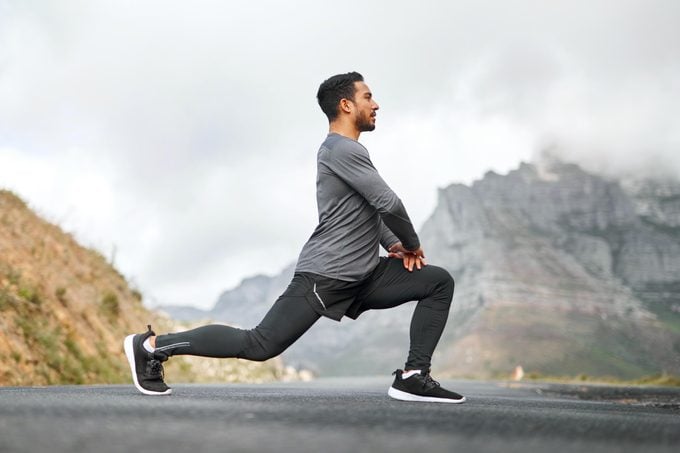
Simply engaging your abdominal muscles may be one of the gentlest—yet most important—ways to strengthen your core. “The most gentle way to train the core is to work the abdominal muscles statically while you train everything else,” Herbst says. “When you squat, lunge, biceps curl, etc., you should contract your abs as if you were going to be punched in the stomach, which works your core without stressing your lumbar spine or discs like crunches or twists.”
Try this when you walk, too—it’s minimal effort with worthwhile results.
The One Core Exercise Every Woman Should Be Doing
Plank
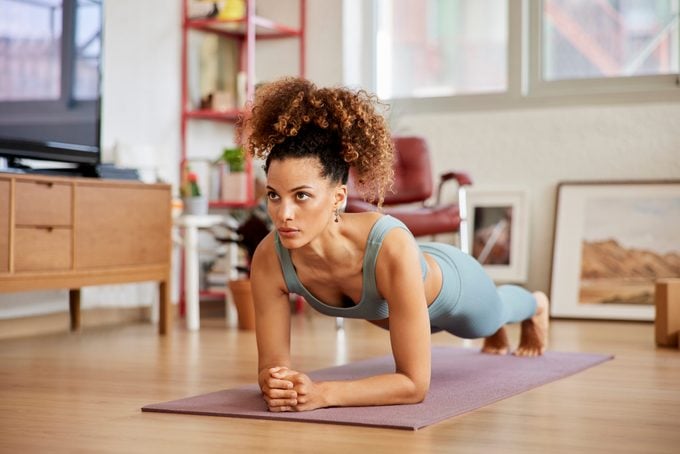
The plank is one of the best core exercises because it helps to strengthen your core through engaging muscles of the abdominals, the back and the pelvis. Plank is a low-impact exercise that can be modified for different strength and ability levels.
“Start in a push-up position with your hands under your shoulders and your feet hip-width apart,” instructs Rob Wagener, NASM Certified Personal Trainer and Nutrition Coach. “Then engage your core and hold this position for 30 seconds to a minute.”
If this feels too challenging, you can do plank with your knees on the ground to take some weight off your upper body. Repeat for a few sets, slowly building up the time, but be mindful of your form and keep your back strong. There are also variations on plank to strengthen your core.
Here’s How and Why You Need to Engage Your Core
Bridge
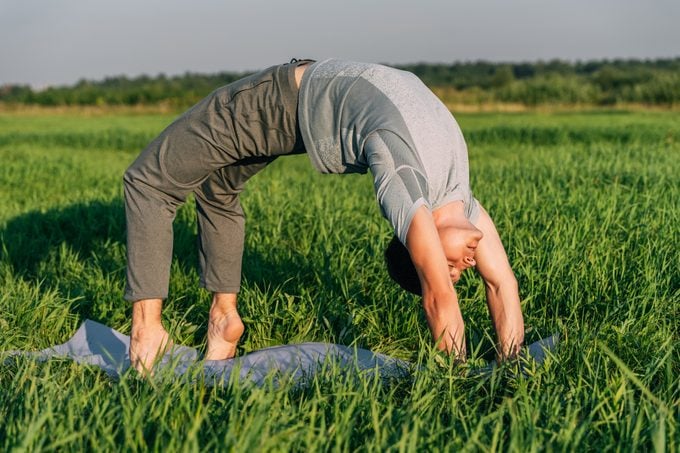
Dr. Lees recommends bridge for a gentle core exercise. “Lie flat on a mat with knees bent, but don’t arch the back or press it tightly to the mat,” he says. “Tighten abdominal muscles. Raise hips off the floor keeping hips, knees and shoulders aligned. Hold as long as comfortable. Lower slowly back to the mat.”
You can repeat this ten times at first, adding additional sets as you’re able.
6 Pilates Moves for a Stronger Core
Bird dog
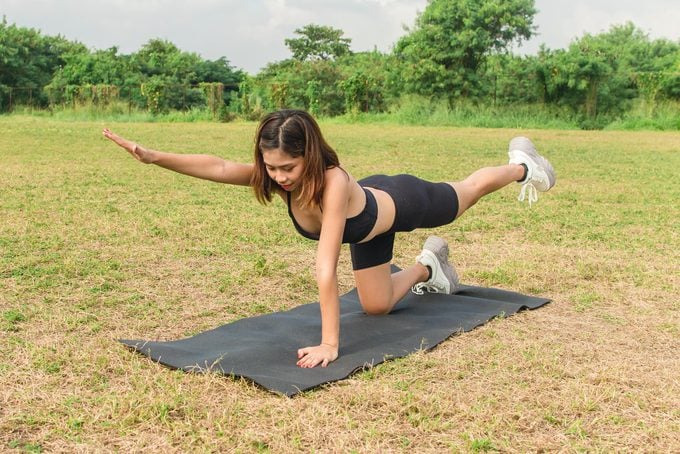
Dr. Kelly Kessler, DPT, is a doctor of physical therapy and certified strength and conditioning specialist who suffered from chronic back pain and was told she’d never heal. But she did, and now she helps others live pain-free. Dr. Kessler recommends “bird dog” for a gentle core exercise that also challenges balance.
Bird dog is a good exercise for strengthening the back and improving the stability of the whole trunk. “Get into the position of a quadruped (with both hands and knees on the ground), and start by lifting one leg upward and holding it while squeezing the trunk muscles,” Dr. Kessler says. “If you can balance, lift the opposite arm up and out in front of you and hold. If this is too difficult, just do one limb at a time.”
Improve Your Posture with These Rounded Shoulder Exercises
Diaphragmatic breathing
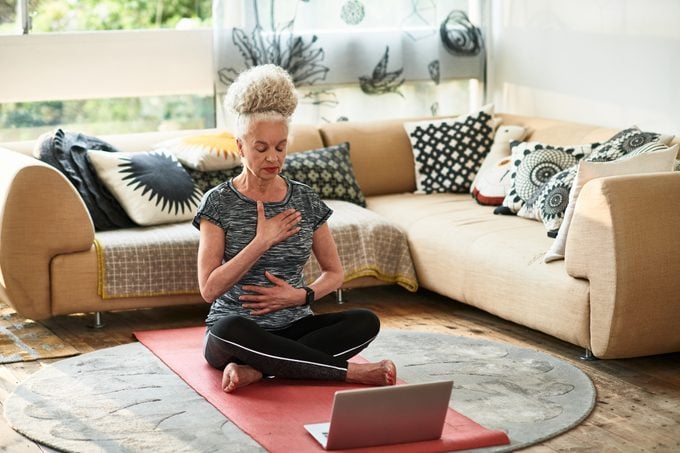
“The most gentle core exercise in the world is breathwork,” says Dr. Camille Ronesi, PT, DPT, FMS 2, a doctor of physical therapy. You might think that sounds ridiculous—it’s just breathing—so how can it strengthen your core? Dr. Ronesi says when it’s done intentionally, diaphragmatic breathing—also known as “deep-belly breathing”—is a terrific core exercise. In addition to working the abdominals, deep belly breathing is excellent for relieving stress and anxiety. (It can also help you prevent, or recover from, respiratory illnesses like COVID-19).
“Lie flat on your back with the backs of your calves resting on the seat of a chair and take an inhale, ideally through the nose rather than the mouth,” Dr. Ronesi explains. “When you exhale, gently blow through pursed lips for as long as you possibly can. Toward the end of that exhale, you will notice tension in the lower abdomen. Hold that tension for three seconds, then inhale and release. Take one to two normal breaths, then repeat. The goal is to increase your awareness of the deep contraction of your core. Eventually, you’ll be able to create that tension without the exhale.”

















